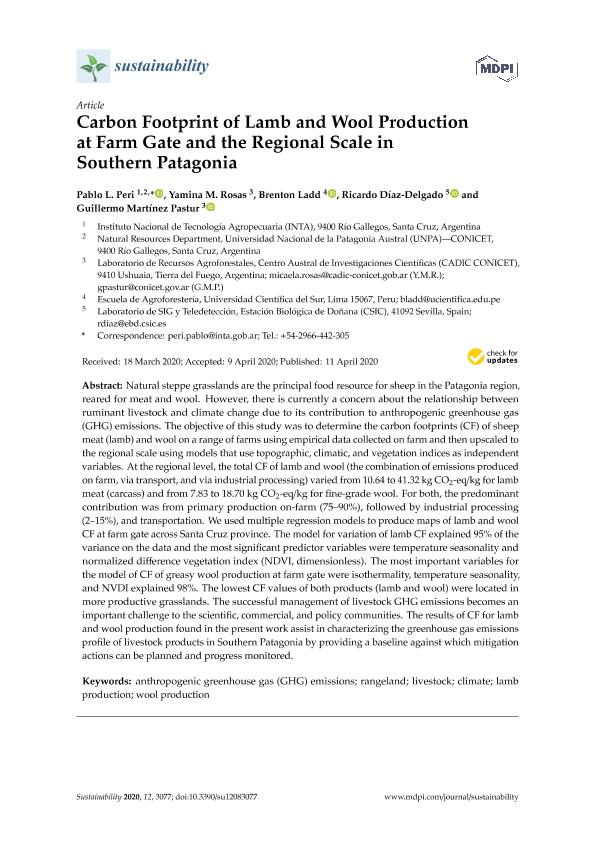Artículo
Carbon footprint of lamb and wool production at farm gate and the regional scale in Southern Patagonia
Peri, Pablo Luis ; Rosas, Yamina Micaela
; Rosas, Yamina Micaela ; Ladd, Brenton; Díaz Delgado, Ricardo; Martínez Pastur, Guillermo José
; Ladd, Brenton; Díaz Delgado, Ricardo; Martínez Pastur, Guillermo José
 ; Rosas, Yamina Micaela
; Rosas, Yamina Micaela ; Ladd, Brenton; Díaz Delgado, Ricardo; Martínez Pastur, Guillermo José
; Ladd, Brenton; Díaz Delgado, Ricardo; Martínez Pastur, Guillermo José
Fecha de publicación:
04/2020
Editorial:
Molecular Diversity Preservation International
Revista:
Sustainability
ISSN:
2071-1050
Idioma:
Inglés
Tipo de recurso:
Artículo publicado
Clasificación temática:
Resumen
Natural steppe grasslands are the principal food resource for sheep in the Patagonia region, reared for meat and wool. However, there is currently a concern about the relationship between ruminant livestock and climate change due to its contribution to anthropogenic greenhouse gas (GHG) emissions. The objective of this study was to determine the carbon footprints (CF) of sheep meat (lamb) and wool on a range of farms using empirical data collected on farm and then upscaled to the regional scale using models that use topographic, climatic, and vegetation indices as independent variables. At the regional level, the total CF of lamb and wool (the combination of emissions produced on farm, via transport, and via industrial processing) varied from 10.64 to 41.32 kg CO2-eq/kg for lamb meat (carcass) and from 7.83 to 18.70 kg CO2-eq/kg for fine-grade wool. For both, the predominant contribution was from primary production on-farm (75-90%), followed by industrial processing (2-15%), and transportation. We used multiple regression models to produce maps of lamb and wool CF at farm gate across Santa Cruz province. The model for variation of lamb CF explained 95% of the variance on the data and the most significant predictor variables were temperature seasonality and normalized difference vegetation index (NDVI, dimensionless). The most important variables for the model of CF of greasy wool production at farm gate were isothermality, temperature seasonality, and NDVI explained 98%. The lowest CF values of both products (lamb and wool) were located in more productive grasslands. The successful management of livestock GHG emissions becomes an important challenge to the scientific, commercial, and policy communities. The results of CF for lamb and wool production found in the present work assist in characterizing the greenhouse gas emissions profile of livestock products in Southern Patagonia by providing a baseline against which mitigation actions can be planned and progress monitored.
Archivos asociados
Licencia
Identificadores
Colecciones
Articulos(CADIC)
Articulos de CENTRO AUSTRAL DE INVESTIGACIONES CIENTIFICAS
Articulos de CENTRO AUSTRAL DE INVESTIGACIONES CIENTIFICAS
Articulos(SEDE CENTRAL)
Articulos de SEDE CENTRAL
Articulos de SEDE CENTRAL
Citación
Peri, Pablo Luis; Rosas, Yamina Micaela; Ladd, Brenton; Díaz Delgado, Ricardo; Martínez Pastur, Guillermo José; Carbon footprint of lamb and wool production at farm gate and the regional scale in Southern Patagonia; Molecular Diversity Preservation International; Sustainability; 12; 8; 4-2020; 1-26
Compartir
Altmétricas



